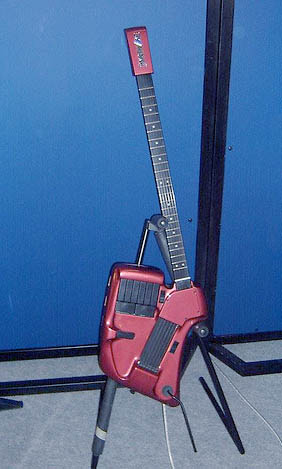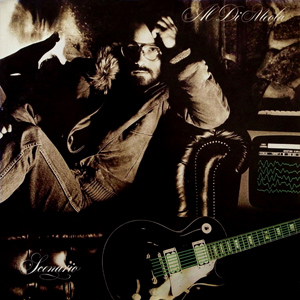Related Research Articles

Robert Steven "Adrian" Belew is an American musician, singer, songwriter, and record producer. A multi-instrumentalist primarily known as a guitarist and singer, he is noted for his unusual and impressionistic approach to his guitar tones.

The Roland JX-3P is a synthesizer produced by Roland Corporation of Japan from 1983–1985. The "3P" in its name refers to "Programmable Preset Polyphonic". It is notable as one of the company's first synthesizers to incorporate a MIDI interface.
Keytar is a keyboard instrument similar to a synthesizer or MIDI controller that is supported by a strap around the neck and shoulders, similar to the way a guitar is held.
"Matte Kudasai" literally "Wait, Please" in Japanese, is a ballad by the progressive rock band King Crimson. Featuring vocals by Adrian Belew, it was released as the first single from the album Discipline (1981). In the UK, the single just missed the chart.
The Yamaha AN1x is a DSP-based analog modeling synthesizer, produced by Yamaha Corporation from 1997 to 1998, and was marketed as an "analog physical modelling control synthesizer".

The SynthAxe is a fretted, guitar-like MIDI controller, created by Bill Aitken, Mike Dixon, and Tony Sedivy and manufactured in England in 1985. It is a musical instrument that uses electronic synthesizers to produce sound and is controlled through the use of an arm resembling the neck of a guitar in form and in use. Its name comes from the words synthesizer and axe, a slang term meaning guitar. The system was developed as a joint venture funded by Richard Branson's Virgin Group.

A MIDI controller is any hardware or software that generates and transmits Musical Instrument Digital Interface (MIDI) data to MIDI-enabled devices, typically to trigger sounds and control parameters of an electronic music performance. They most often use a musical keyboard to send data about the pitch of notes to play, although a MIDI controller may trigger lighting and other effects. A wind controller has a sensor that converts breath pressure to volume information and lip pressure to control pitch. Controllers for percussion and stringed instruments exist, as well as specialized and experimental devices. Some MIDI controllers are used in association with specific digital audio workstation software. The original MIDI specification has been extended to include a greater range of control features.

The Fender Mustang is a solid body electric guitar produced by the Fender Musical Instruments Corporation. It was introduced in 1964 as the basis of a major redesign of Fender's student models, the Musicmaster and Duo-Sonic. It was produced until 1982 and reissued in 1990.

Electro-Harmonix is a New York City-based company that makes electronic audio processors and sells rebranded vacuum tubes. The company was founded by Mike Matthews in 1968. It is best known for a series of guitar effects pedals introduced in the 1970s and 1990s. EHX also made a line of guitars in the 1970s.

DiMarzio, Inc. is an American manufacturer best known for its direct-replacement guitar pickups. The company also produces other guitar accessories, such as hardware, guitar straps, and instrument cables.

A wind controller, sometimes referred to as a wind synthesizer, is an electronic wind instrument. It is usually a MIDI controller associated with one or more music synthesizers. Wind controllers are most commonly played and fingered like a woodwind instrument, usually the saxophone, with the next most common being brass fingering, particularly the trumpet. Models have been produced that play and finger like other acoustic instruments such as the recorder or the tin whistle. The most common form of wind controller uses electronic sensors to convert fingering, breath pressure, bite pressure, finger pressure, and other gesture or action information into control signals that affect musical sounds. The control signals or MIDI messages generated by the wind controller are used to control internal or external devices such as analog synthesizers or MIDI-compatible synthesizers, synth modules, softsynths, sequencers, or even non-instruments such as lighting systems.

Scenario is an album by jazz guitarist Al Di Meola, released in 1983. Musicians include keyboardist Jan Hammer, bassist Tony Levin and drummers Bill Bruford and Phil Collins.

The Roland JD-800 is a digital synthesizer that was manufactured between 1991 and 1996. It features many knobs and sliders for patch editing and performance control — features that some manufacturers, including Roland, had been omitting in the name of streamlining since the inception of the Yamaha DX7. The JD-800 thus became very popular with musicians who wished to take a hands-on approach to patch programming. The introduction in the manual states that Roland's intention with the JD-800 was to "return to the roots of synthesis".

A guitar synthesizer is any one of a number of musical instrument systems that allow a guitarist to access synthesizer capabilities.

The Rickenbacker 330 is part of Rickenbacker's 300 series of guitars. The 330 entered the Rickenbacker product line in 1958, though at the time the 300 series of guitars was known as the "Capri" series. It was designed by the German luthier Roger Rossmeisl. The guitar is associated by many players with the jangle-rock sounds of bands from the 1960s and 1980s. The instrument incorporates many features standard on Rickenbacker guitars, including a three-ply maple/walnut neck, a shallow headstock angle, and a thick rosewood fretboard finished with clear conversion varnish. The 330 also features a body with Rickenbacker's "crescent moon" double-cutaway shape with sharp, unbound edges, and an "R"-shaped trapeze tailpiece. One idiosyncrasy of the guitar is its dual truss rods, which allow for the correction of problematic and unwanted twists, as well as curvature, of the guitar's neck. The 330 is equipped with a monaural jack plate, lacking the Rick-O-Sound stereo functionality of other Rickenbacker models such as the Rickenbacker 360.
The Roland GR-500 is a guitar synthesizer. Manufactured by the Roland Corporation and FujiGen in 1977, it was one of the first guitar synthesizers.
The Rickenbacker 4001 is an electric bass that was manufactured by Rickenbacker as a two-pickup "deluxe" version of their first production bass, the single-pickup model 4000. This design, created by Roger Rossmeisl, was manufactured between 1961 and 1981, when it was replaced by an updated version dubbed the Rickenbacker 4003. Variant models of the 4001 include the 4001S, 4001LH, 1999, 4001V63 (reissue), 4001CS and the 4001C64 and 4001C64S: the C Series is a recreation of Paul McCartney's left-handed 4001S with a reversed headstock. There are also Al Cisneros and Lemmy Kilmister signature versions of the instrument.
The Roland GR-300 is an analog guitar synthesizer manufactured by Roland Corporation. It was introduced to market in 1980.
The SH-01 Gaia, is a sixty four voice polyphonic virtual analogue synthesizer introduced by Roland Corporation in 2010.
The Roland SP-808 GrooveSampler and SP-808EX/E-Mix Studio are both discontinued workstations, which function as digital samplers, synthesizers, and music sequencers. The digital samplers are a part of the long line of both Roland Corporation's and Boss Corporation's Groove Gear, which includes the more popular and successful Boss SP-303 and Roland SP-404 versions.
References
- 1 2 Roland GR-1 Guitar Synthesizer, encyclotronic.com
- ↑ Robert Fripp's Roland GR-1 Guitar Synthesizer, Equipboard.com
- ↑ Al Di Meola's Roland GR-1 Guitar Synthesizer, Equipboard.com
- ↑ Underworld's Roland GR-1 Guitar Synthesizer, Equipboard.com
- ↑ Performing on the GR-1 Randy Resnick bio and live performances